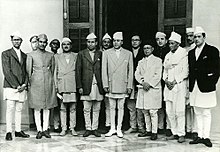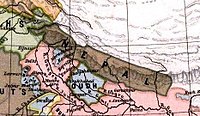|
1951 Nepalese revolution
The revolution of 1951 (Nepali: सात सालको क्रान्ति, romanized: Sāta Sālako Krānti) in Nepal, also referred to as Sat Salko Kranti, was a political movement against the direct rule by the Rana dynasty of Nepal which had lasted for 104 years. Background of Rana regimeOrganization for revolutionPopular dissatisfaction with the Ranas began to surface among educated individuals, including many from within the Rana ruling class who supported more democratic views. Some Nepalese who had participated in the Indian independence movement and experienced exile were eager to liberate Nepal from Rana rule. These individuals sought to bring about political change and end the Rana regime in Nepal. Uprisings and incidentsNepal Praja ParishadThe founding of the Nepal Praja Parishad was proposed by Dashrath Chand and Tanka Prasad Acharya in a hotel in Bhimphedi, Makwanpur District of Nepal. It was founded in 1936 when they received the support of additional people including Dharma Bhakta Mathema among others.[1] The organization's head office was kept in Dharma Bhakta Mathema's house in OmBahal.[2] National congressOn January 26, 1947, the Nepali National Congress was formed in India under the leadership of Bishweshwar Prasad Koirala. Since establishment Congress organized underground activities but on March 4, 1947 (Falgun, 2003 B.S.) Workers of Biratnagar Jute mill demonstrated and started striking against the management.[3]: 62 under the leadership of Girija Prasad Koirala and Bishweshwar Prasad Koirala. Nepali National Congress participated in this Biratnagar jute mill strike, supporting the strikers[3]: 61 and demanded a Political labour union. Jayatu SanskritamKing Tribhuvan's exile Nepali Congress's Liberation ArmyAfter King Tribhuvan fled to the Indian embassy, the Nepali Congress Party launched a military wing called Nepali Congress's Liberation Army, and started an armed uprising against the Rana rule.[4] Delhi AccordAfter a mutual agreement between Ranas, Nepali Congress and King Tribhuvan, a tripartite agreement was signed in Delhi. Finally, On February 18, 1951 (7th Falgun 2007 B.S.), King Tribhuvan returned to Nepal as head of state. Formation of the Coalition GovernmentOn 15 February 1951, King Tribhuvan and the leading members of the Nepali Congress returned to Kathmandu. From the Ranas:
From the Nepali Congress side:
This cabinet was reshuffled on 10 June 1951 to replace Baber Shamsher by Shangha Shamsher and Bharatmani Sharma by Surya Prasad Upadhyaya Aftermath
See also
References
|
|||||||||||||||||||||||||||||||||||||||

